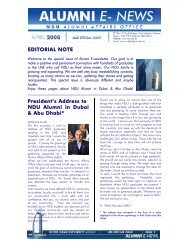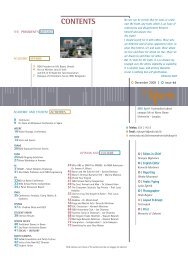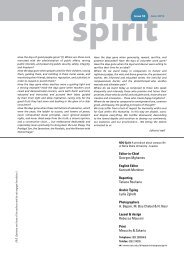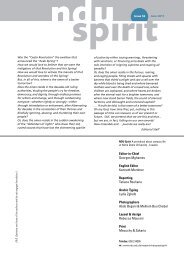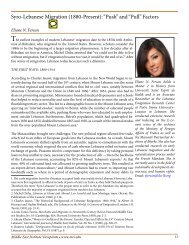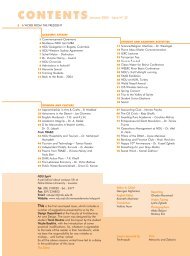OUTLINE - Notre Dame University
OUTLINE - Notre Dame University
OUTLINE - Notre Dame University
You also want an ePaper? Increase the reach of your titles
YUMPU automatically turns print PDFs into web optimized ePapers that Google loves.
issue of global warming<br />
which is associated with<br />
the release of greenhouse<br />
gases, especially carbon<br />
dioxide.<br />
Then he talked about lead<br />
pollution, which is caused<br />
by arms and ammunition,<br />
lead pipes, smelters,<br />
improper disposal of<br />
household and automobile<br />
batteries, and leaded<br />
gasoline. Tetraethyl lead<br />
was discovered by<br />
Thomas Midgley in 1922<br />
and was considered a<br />
great achievement in the<br />
automobile industry<br />
because it is an anti-knocking<br />
agent in engines.<br />
However, when leaded<br />
gasoline is burned, lead<br />
particulates are released<br />
into the air. When people<br />
breath in the lead-polluted<br />
air, the lead accumulates<br />
in the body and causes<br />
brain and other nervous<br />
system damage, including<br />
mental retardation, especially<br />
in children.<br />
Finally Dr. Hanna gave a<br />
general overview about air<br />
pollution in Lebanon. He<br />
noted that there is a lack of<br />
scientific research regarding<br />
the extent of the air<br />
pollution in Lebanon and<br />
its effect on people’s<br />
health since not many<br />
studies have been con-<br />
Dr. Robert Hanna addressing his audience. Dr. Hanna’s large and interested audience took notes.<br />
ducted; however, he did<br />
discuss several studies<br />
which indicate that air pollution<br />
and its negative<br />
health effects are as much<br />
a problem in some regions<br />
in Lebanon as they are in<br />
many more industrialized<br />
countries.<br />
Although Lebanon is not a<br />
major industrialized country,<br />
most of the air pollution<br />
in Lebanon is due to<br />
the burning of fossil fuels<br />
and what industries<br />
release from their smokestacks.<br />
The industries present<br />
in Lebanon are smallscale<br />
and are mostly concentrated<br />
in the areas of<br />
Chekka and Selaata.<br />
Sources of stationary air<br />
pollution include the<br />
power plants that use fuel<br />
oil such as the Zouk, Gieh,<br />
and Harisheh stations and<br />
the plants that use diesel<br />
fuel such as those at Tyre,<br />
Zahrani, Deir Amer and<br />
Baalbeck. Other major<br />
sources of air pollution<br />
include the cement and<br />
chemical companies and<br />
the burning of solid waste.<br />
It has been documented<br />
that before the Amrousieh<br />
incinerator was shut<br />
down, physicians in the<br />
area noticed a large number<br />
of cases of respiratory<br />
disease among the local<br />
inhabitants. In a study<br />
conducted in 1993, the<br />
AUB Faculty of Medicine<br />
compared the effect of air<br />
pollution and particulates<br />
from the Zouk power<br />
plant on the health of the<br />
inhabitants in this region<br />
as compared to the inhabitants<br />
of Amchit. In many<br />
ways, the Zouk region is<br />
comparable to Amchit<br />
except for the presence of<br />
the power plant. This<br />
study showed that the<br />
presence of the Zouk<br />
power plant had a direct<br />
affect on the health of the<br />
inhabitants. Specifically,<br />
the percentage of people<br />
with respiratory diseases<br />
in the Zouk area was more<br />
than three times the percentage<br />
for the residents<br />
of Amchit. In a different<br />
study conducted by Dr.<br />
George Ayoub and Dr.<br />
Farid Chaaban, it was<br />
found that the levels of<br />
sulfur dioxide in the vicinity<br />
of the power plants of<br />
Zouk and Jiah sometimes<br />
exceeded the maximum<br />
limit allowed in the United<br />
States. All this air pollution<br />
carries a very high price<br />
tag. It has been estimated<br />
that the cost of treating the<br />
diseases resulting from air<br />
pollution in Lebanon<br />
exceeds 130 million dollars<br />
annually.<br />
Dr. Hanna concluded his<br />
talk by informing the audience<br />
that the major contributor<br />
to air pollution in<br />
Lebanon is motor vehicles.<br />
When Lebanon achieved<br />
its independence from<br />
France in 1948, the number<br />
of cars in the whole<br />
country did not exceed<br />
3,400. In 1998, only 50<br />
years later, there were<br />
1,400,000 cars and the<br />
number continues to<br />
increase steadily. Now<br />
there is one car for every<br />
three persons in Lebanon,<br />
which is comparable to<br />
many industrialized countries.<br />
As has been noted<br />
before, one major source<br />
of air pollution from motor<br />
vehicles is lead particulates.<br />
It has been estimated<br />
that around 850 kilograms<br />
of lead are released into<br />
the air of Beirut annually,<br />
primarily from motor<br />
vehicle exhausts. This is<br />
particularly harmful to<br />
people who live or work<br />
on or near major roadways.<br />
For example, traffic<br />
police were found to have<br />
the highest levels of lead<br />
contamination in their<br />
blood due to their constant<br />
work-related exposure.<br />
Thankfully, this problem is<br />
now being resolved since<br />
most imported gasoline is<br />
now unleaded. N<br />
30 NNU SPIRIT



